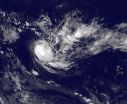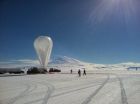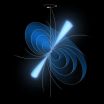(Press-News.org) Tropical Cyclone Garry is in a good environment to intensify and satellite imagery from NOAA's GOES-15 satellite helped confirm that the storm has become more organized.
NOAA's GOES-15 satellite captured an infrared image of Tropical Storm Garry when it was located about 330 nautical miles (379.8 miles/ 611.2 km) east of Pago Pago, American Samoa. The image, created by the NASA GOES Project at the NASA Goddard Space Flight Center in Greenbelt, Md., was taken Jan. 24 at 1500 UTC (10 a.m. EST). The image showed a bright white circle of clouds that indicate strong thunderstorms were wrapping around the center of circulation as Garry continues to intensify. The latest bulletin from the Joint Typhoon Warning Center noted that microwave satellite imagery confirmed deep convection wrapping almost entirely around Garry's well-defined low level circulation center.
NOAA's GOES-15 satellite is in a fixed orbit over the Pacific Ocean, midway between Hawaii and the West Coast and 22,300 miles above the equator. GOES-15 provides a good view of what is happening in U.S. west and in the Pacific Ocean.
On Jan. 24 at 0900 UTC, Garry's maximum sustained winds had increased to 60 knots (69 mph/111.1 kph). Garry's tropical-storm-force winds extend about 55 nautical miles (63.3 miles/102 km) from the center, making it a compact tropical cyclone. It was centered near 14.0 south latitude and 164.9 west longitude and moving to the southeast at 11 knots (12.6 mph/20.3 kph).
Forecasters at JTWC expect that Garry will continue moving southeast and is expected to pass far south of French Polynesia. Garry is expected to briefly reach cyclone (hurricane) strength before wind shear weakens and dissipates the storm.
INFORMATION:
NASA sees Tropical Cyclone Garry continue to intensify
2013-01-25
ELSE PRESS RELEASES FROM THIS DATE:
NASA sees remnants of Tropical Storm Oswald still strong
2013-01-25
Infrared imagery from NASA's Aqua satellite revealed that a band of thunderstorms on the eastern side of Tropical Storm Oswald's remnants still contained some punch. Oswald's remnants have triggered severe weather warnings in parts of Queensland, Australia.
When NASA's Aqua satellite passed over the eastern side of the remnants of Tropical Cyclone Oswald the Atmospheric Infrared Sounder (AIRS) instrument captured an infrared image of a powerful band of thunderstorms over the Coral Sea. The band of thunderstorms east of Oswald's center showed some strong convection and ...
NASA Super-TIGER balloon shatters flight record
2013-01-25
Flying high over Antarctica, a NASA long duration balloon has broken the record for longest flight by a balloon of its size.
The record-breaking balloon, carrying the Super Trans-Iron Galactic Element Recorder (Super-TIGER) experiment, has been afloat for 46 days and is on its third orbit around the South Pole.
"This is an outstanding achievement for NASA's Astrophysics balloon team," said John Grunsfeld, associate administrator for the Science Mission Directorate at NASA Headquarters in Washington. "Keeping these huge balloons aloft for such long periods lets us do ...
Fetal exposure to tributyltin linked to obesity
2013-01-25
Irvine, Calif. (Corrected version) — Exposing pregnant mice to low doses of the chemical tributyltin (TBT) – which was used in marine antifouling paints and is used as an antifungal agent in some paints, certain plastics and a variety of consumer products – can lead to obesity for multiple generations without subsequent exposure, a UC Irvine study has found.
After exposing pregnant mice to TBT at low concentrations, similar to those found in the environment and in humans, researchers observed increased body fat, liver fat and fat-specific gene expression in liver and ...
Maglev tissues could speed toxicity tests
2013-01-25
In a development that could lead to faster and more effective toxicity tests for airborne chemicals, scientists from Rice University and the Rice spinoff company Nano3D Biosciences have used magnetic levitation to grow some of the most realistic lung tissue ever produced in a laboratory.
The research is part of an international trend in biomedical engineering to create laboratory techniques for growing tissues that are virtually identical to those found in people's bodies. In the new study, researchers combined four types of cells to replicate tissue from the wall of ...
Chameleon star baffles astronomers
2013-01-25
Pulsars—tiny spinning stars, heavier than the sun and smaller than a city—have puzzled scientists since they were discovered in 1967.
Now, new observations by an international team, including University of Vermont astrophysicist Joanna Rankin, make these bizarre stars even more puzzling.
The scientists identified a pulsar that is able to dramatically change the way in which it shines. In just a few seconds, the star can quiet its radio waves while at the same time it makes its X-ray emissions much brighter.
The research "challenges all proposed pulsar emission theories," ...
Low vitamin D levels linked to high risk of premenopausal breast cancer
2013-01-25
A prospective study led by researchers from the University of California, San Diego School of Medicine has found that low serum vitamin D levels in the months preceding diagnosis may predict a high risk of premenopausal breast cancer.
The study of blood levels of 1,200 healthy women found that women whose serum vitamin D level was low during the three-month period just before diagnosis had approximately three times the risk of breast cancer as women in the highest vitamin D group. The study is currently published online in advance of the print edition of the journal ...
Do non-steroidal anti-inflammatory drugs cause kidney failure in children?
2013-01-25
Cincinnati, OH, January 25, 2013 -- Non-steroidal anti-inflammatory drugs (NSAIDs), such as ibuprofen and naproxen, are commonly used to treat pain and reduce fever in children. However, the use of NSAIDs has been shown to cause acute kidney injury (AKI) in some children. A new study scheduled for publication in The Journal of Pediatrics reports the findings on the number of children diagnosed with AKI caused by NSAIDs in one hospital over an 11 ½ year span.
Dr. Jason Misurac and colleagues from the Indiana University School of Medicine and Butler University retrospectively ...
Frontiers publishes systematic review on the effects of yoga on major psychiatric disorders
2013-01-25
Yoga has positive effects on mild depression and sleep complaints, even in the absence of drug treatments, and improves symptoms associated with schizophrenia and ADHD in patients on medication, according to a systematic review of the exercise on major clinical psychiatric disorders.
Published in the open-access journal, Frontiers in Psychiatry, on January 25th, 2013, the review of more than one hundred studies focusing on 16 high-quality controlled studies looked at the effects of yoga on depression, schizophrenia, ADHD, sleep complaints, eating disorders and cognition ...
Common anti-fever medications pose kidney injury risk for children
2013-01-25
Sick children, especially those with some dehydration from flu or other illnesses, risk significant kidney injury if given drugs such as ibuprofen and naproxen, Indiana University School of Medicine researchers said Friday.
In an article published online Jan. 25 by the Journal of Pediatrics, Jason Misurac, M.D., and colleagues from IU and Butler University reported that nearly 3 percent of cases of pediatric acute kidney injury over a decade could be traced directly to having taken the common nonsteroidal anti-inflammatory drugs, or NSAIDs.
Although relatively few ...
Tumor cells engineer acidity to drive cell invasion, Moffitt Cancer Center researchers say
2013-01-25
Researchers at Moffitt Cancer Center and colleagues at Wayne State University School of Medicine investigated the acidity in solid tumors to determine if pH levels play a role in cancer cell invasion in surrounding tissues. They found that an acidic microenvironment can drive cancer cells to spread and propose that neutralizing pH would inhibit further invasion, providing a therapeutic opportunity to slow the progression of cancers.
Their study appeared in the Jan. 3 online release of Cancer Research, a publication of the American Association for Cancer Research.
According ...



